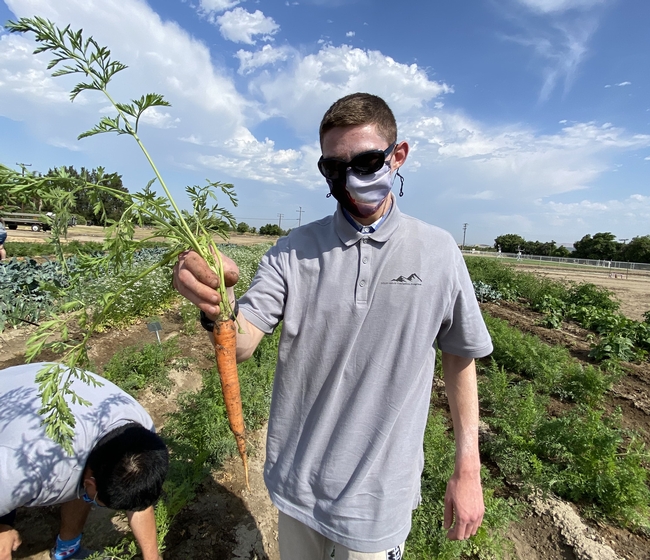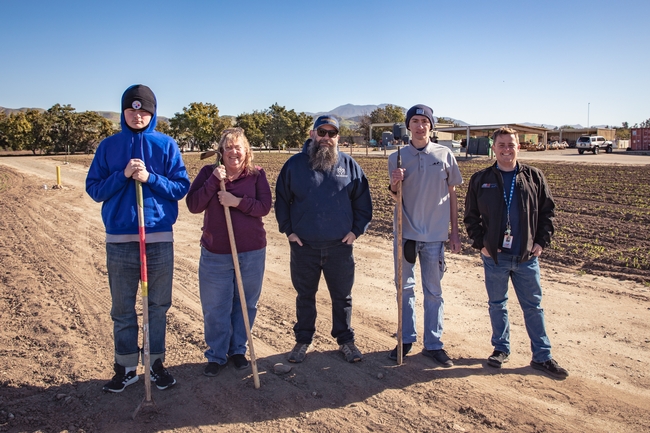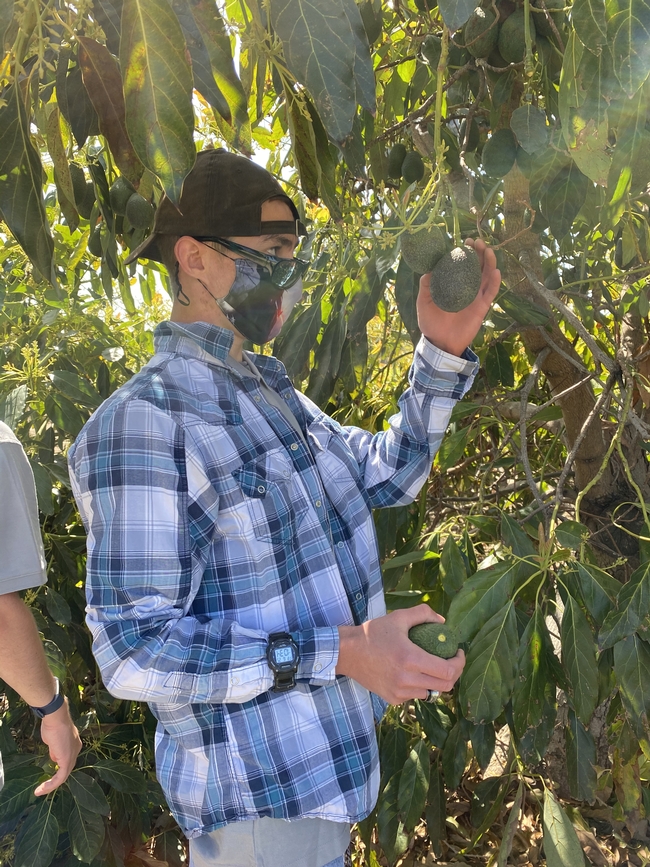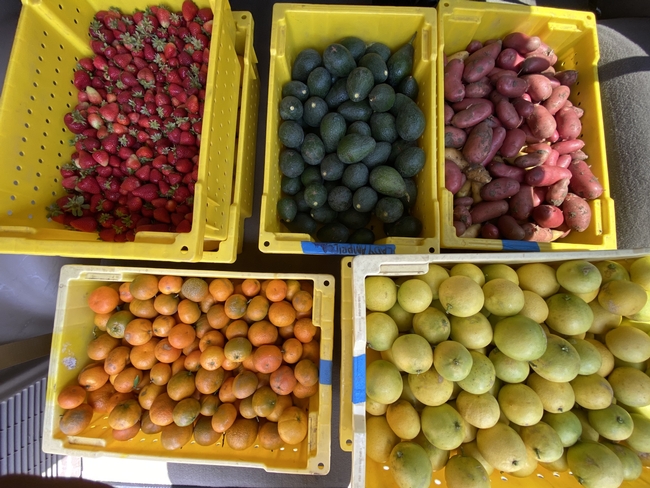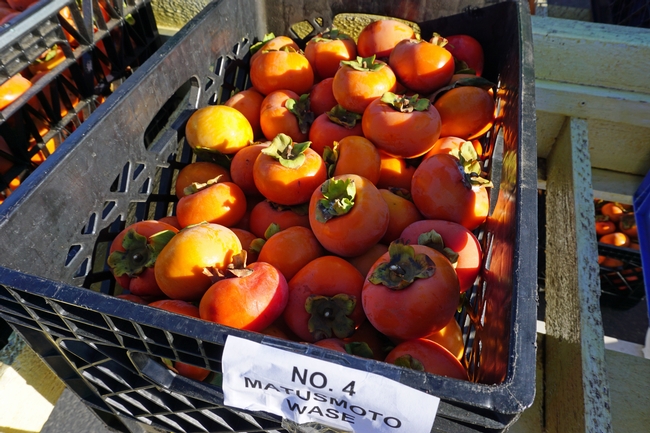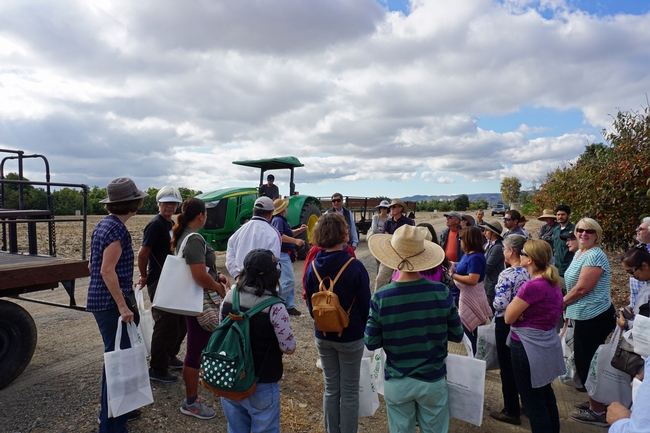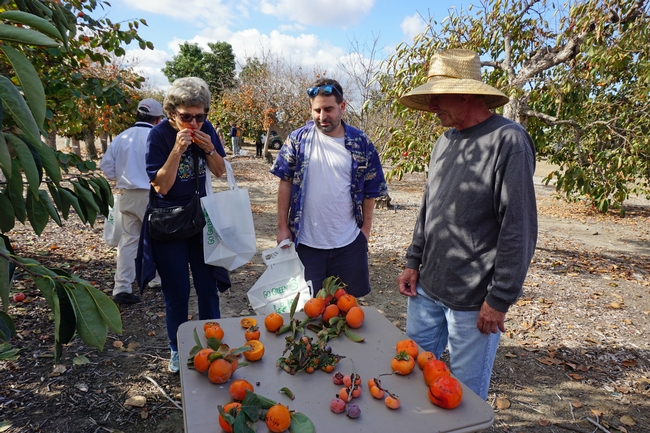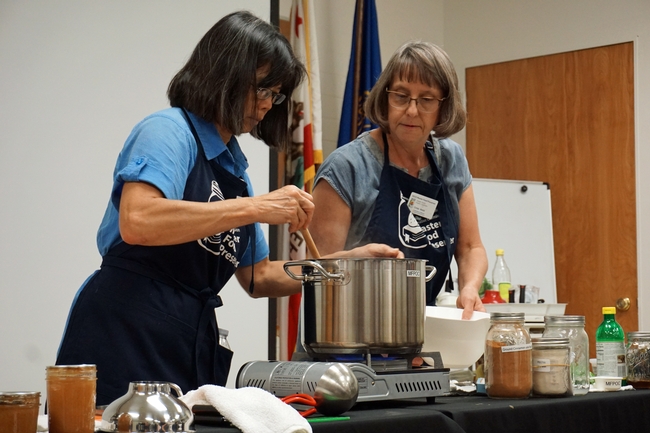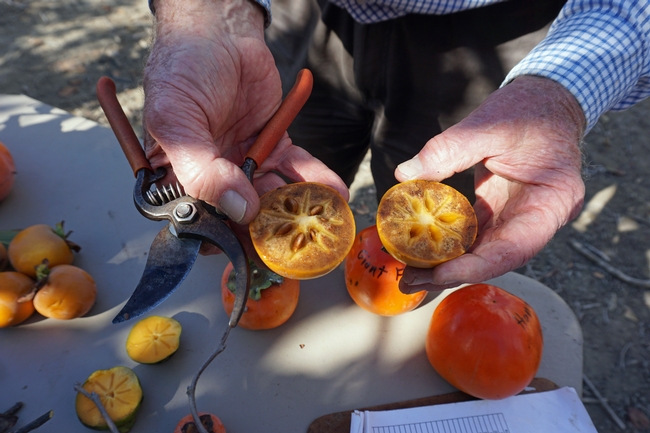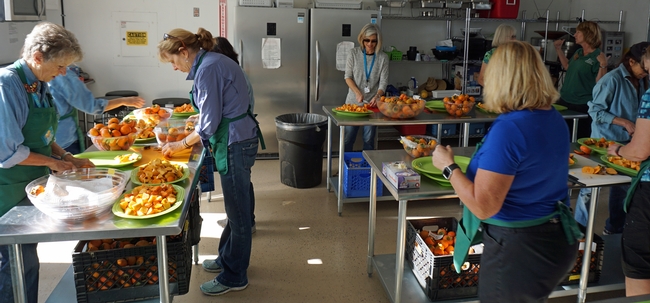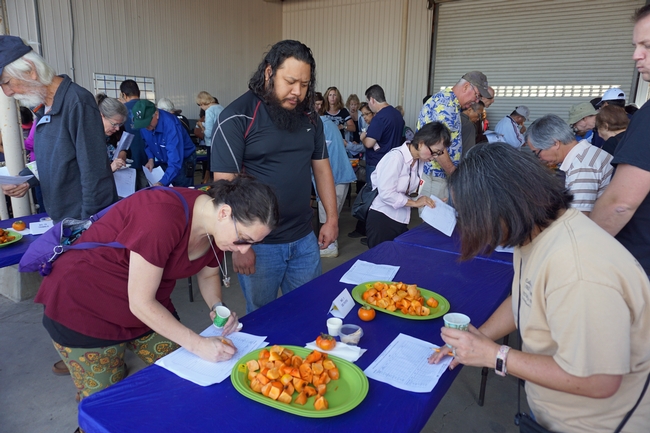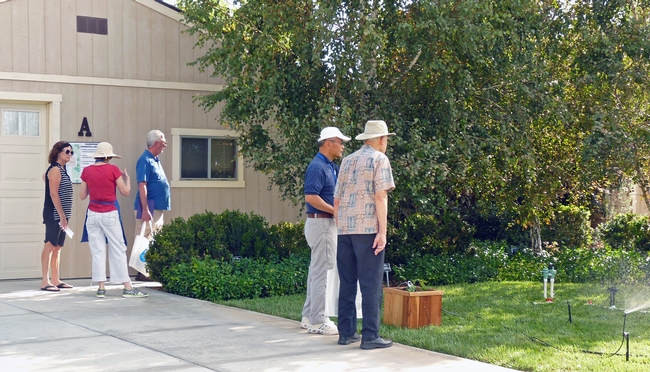Posts Tagged: Tammy Majcherek
Special education students cultivate farm skills at South Coast REC
Partnership with Esperanza Education Center provides blueprint for other adult transition programs
For students at Esperanza Education Center, an adult transition program serving students with disabilities in south Orange County, there was something deeply satisfying about handpicking 2,000 pounds of avocados.
“There's a tangible, visual element where you're like, ‘Wow, I did that – I did it, I can see it, I can feel it in my bones and my muscles,'” said Ray Bueche, principal of the school in Mission Viejo, within the Saddleback Valley Unified School District. “There's a real sense of accomplishment that you're seeing in some of these students.”
Ranging in age from 18 to 22, the students are in an adult education program that helps advance their independent living skills and prepare them for meaningful work and careers. They are able to experience the thrill of the harvest – and a variety of other farming activities – through the school's innovative partnership with UC South Coast Research and Extension Center, a UC Agriculture and Natural Resources facility that supports researchers and delivers outreach and education programs.
Given UC ANR's emphasis on workforce development, Jason Suppes, a community education specialist at South Coast REC, contacted Bueche in 2019 about a potential collaboration. While Esperanza has many partnerships with retail stores and nonprofits that give students invaluable work experiences, none of them offer the farm environment that South Coast REC could provide.
“Part of developing [our students] is getting a wide range of opportunities in a variety of vocational areas,” Bueche explained. “Agriculture is one that's very hard for us to find.”
Program ‘wildly successful' from beginning
Unlike other job sites that bring the students in less frequently, South Coast REC committed to hosting the young people every week for three hours (COVID-19 measures permitting), with Suppes and colleague Tammy Majcherek leading them in planting, weeding, maintenance, harvesting and more.
“We can provide opportunities for students to learn skills that could help them potentially find employment in a garden center, in a nursery, at landscapers,” Suppes said. “The program was wildly successful out of the gate.”
Mike Seyler, an Esperanza teacher who accompanies the students to South Coast REC, has seen firsthand the positive impacts of the partnership. He said one student – who at first balked at the idea of being outside, getting dirty and performing physical labor – eventually grew to like the work and took great pride in pulling carrots from the ground and sharing them with his family.
“To physically actually ‘see' the work you did – they don't always get to do that,” Seyler said. “It was cool to see someone, who didn't necessarily like being outdoors, really enjoy it now.”
The change of pace – and place – was especially beneficial for one young woman at Esperanza. Bueche said the nature of the work and the setting helped the student grow socially, as she relished the teamwork and camaraderie needed to accomplish their goals on the farm.
“We really saw a different person come out through her experiences there – she felt more self-confident; she was more personable with people; she was talking more,” said Bueche, who added that she has leveraged the skills she gained into a paid work-based learning experience with a local retailer.
Students bring produce to school, community
All students benefit from Esperanza's partnership with South Coast REC, as surplus produce from the center's fields is donated to make healthy school lunches. In addition, students use REC-grown fruits and vegetables at their monthly pop-up restaurant, where they hone skills in preparing and serving a three-course meal.
Their peers, who harvested the produce, derive immense satisfaction from seeing the fruits of their labor go directly to the school.
“They're able to enjoy eating the stuff that they're working for,” Seyler said. “And then they see everyone else enjoying it, and I think that really translates well for these guys.”
The students also played a prominent role in an avocado sale last summer, for which they picked 2,000 pounds of produce, bagged the fruit in 10-pound bags and then distributed preorders to the public from a stand at South Coast REC. Proceeds from the event were used to purchase farm tools, shirts and other gear.
“It was an incredible success – everyone loved the avocados,” Bueche said. “The students loved it; the parents came out; community members supported it.”
Those successes illustrate the power of a strong partnership; the South Coast REC team, in fact, received the school's “Community Partner of the Year” Award for 2020-21, for persevering through the pandemic to deliver the beneficial programs for students.
Over the last two years, Suppes and Bueche – through a lot of creativity and some trial and error – have sketched a roadmap for growing productive relationships between similar organizations and adult transition programs. And after presenting those results to colleagues, other local school districts and nonprofits such as Goodwill and My Day Counts have contacted South Coast REC to provide similar experiences for community members.
Thanksgiving persimmons are autumn joy
When the weather cools in the fall and the holidays draw near, orange orbs ripen on persimmon trees in California to offer a fresh autumn sweetness in time for Thanksgiving recipes and holiday décor.
At the UC South Coast Research and Extension Center (SCREC) in Irvine, a collection of 53 persimmon varieties are at their peak in November when the public is invited for tasting and harvesting at the annual persimmon field day.
“We want to raise awareness about persimmons,” said Tammy Majcherek, SCREC community educator. “It's a beautiful tree and a great addition to any landscape. Persimmon trees provide shade in the summer, healthy fruit in the fall, then drop their leaves and allow the sun's warmth to come through in the winter. It's a win-win situation as far as landscape trees go.”
The persimmon collection came to the research center in the 1960s, when the late UCLA subtropical horticulture professor Art Schroeder arranged to move his collection of persimmon varieties to another venue because the pressure of urban development at the Westwood campus became too great.
Persimmons are native in two parts of the world, China and the United States. The Chinese persimmon made its way to Japan, where its popularity soared. The American persimmon comes from the Southeastern United States, however, most California persimmons trace their lineage to Asia.
California leads the nation in persimmon production, according to the California Department of Agriculture Crop Report, but with a value of about $21 million in 2012, it represents just a small fraction of the state's $19 billion 2012 tree fruit and nut value.
Nevertheless, to the visitors who came out to tour UC's collection at SCREC, persimmon is a choice fruit. Participants on the early-morning VIP tour received a large shopping bag to fill with various varieties of fuyu and hachiya persimmons. Fuyu are flat, yellow-orange fruit that can be eaten right off the tree like apples or allowed to mature to a super-sweet soft pulp. Hachiya are redder, heart-shaped and astringent when not fully ripened. “If you bite it, it will bite your mouth right back,” said one participant.
However, after ripening to a jelly soft pulp or dried, the hachiya is equally delicious.
Shirley Salado, the UC Cooperative Extension Expanded Food and Nutrition Education Program supervisor in San Diego County, attended the persimmon tasting to gather fruit and information for her education program.
“The fuyu is great to eat,” Salado said. “When they ripen and become very soft, you can put the pulp in a blender and then freeze in zipper bags to add to healthy smoothies.”
Salado collected two large bags of persimmons to share with her nutrition education staff.
“Not everybody knows about these,” Salado said. “This gives them a chance to look at the fruit. This is what we promote.”
Following the tour, coordinator of the UC Master Food Preserver program at SCREC Cinda Webb demonstrated safe consumption by making cinnamon persimmon jam, dried persimmon chips, and a gourmet persimmon, basil, beet and rice salad.
Wild or brown rice persimmon salad
4 cups wild or brown rice, cooked
2 Fuyu persimmons, chopped
1 cup cooked, chopped beets
1 cup basic, chopped
8 oz feta cheese
½ cup orange cumin vinaigrette
Vinaigrette (makes about 1 cup)
½ cup orange juice
¼ cup olive oil
2 tsp rice vinegar
1 Tbsp maple syrup
1½ tsp cumin
1 tsp coriander
½ tsp salt
Directions
- Whisk together vinaigrette dressing ingredients
- Stir basil, beets, persimmons and feta into rice and toss with ½ cup vinaigrette.
- Top with persimmon slices and extra chopped basil for presentation.
South Coast REC research helps landscapers plan for the next drought
Covering the ongoing drought, Peter King wrote a story in the Los Angeles Times about different approaches being taken around the state to manage with less water. From desalination facilities to solar-powered telemetry towers to help improve irrigation efficiency in an almond orchard to water storage projects, the former UCOP news director highlighted a number of efforts to plan for a drier future. He ended up at UC ANR's South Coast Research and Extension Center, looking at the landscape project built for studying plant types and urban water use.
“Three beige classrooms have been outfitted and landscaped to resemble a row of suburban homes, complete with white picket fences,” King wrote. “They are not-so-poetically identified as residences A, B and C. A offers conventional landscaping: fescue lawn, birch trees and boxwood. B's plants and grasses are better suited to a Mediterranean climate. C's are natives: sedge grasses, manzanita and sycamores.”
As the drought persists, requests from municipal landscapers and private gardeners to tour the project have picked up, Tammy Majcherek, a UCCE community educator in Orange County, told King.
“I am not sure the old mindset has changed,” she said, “but I think maybe we are beginning to turn the corner.”
Members of the public will have a chance to tour the faux neighborhood on Sept. 26 from 9 a.m. to 2 p.m. during the Urban Landscape & Garden Education Expo at South Coast Research and Extension Center. The event is free. Visitors will get to learn about drought friendly plants and how to reduce landscape water use. For more information, visit http://screc.ucanr.edu/?calitem=272378&g=68933.

SCREC landscape expo Sept. 26

